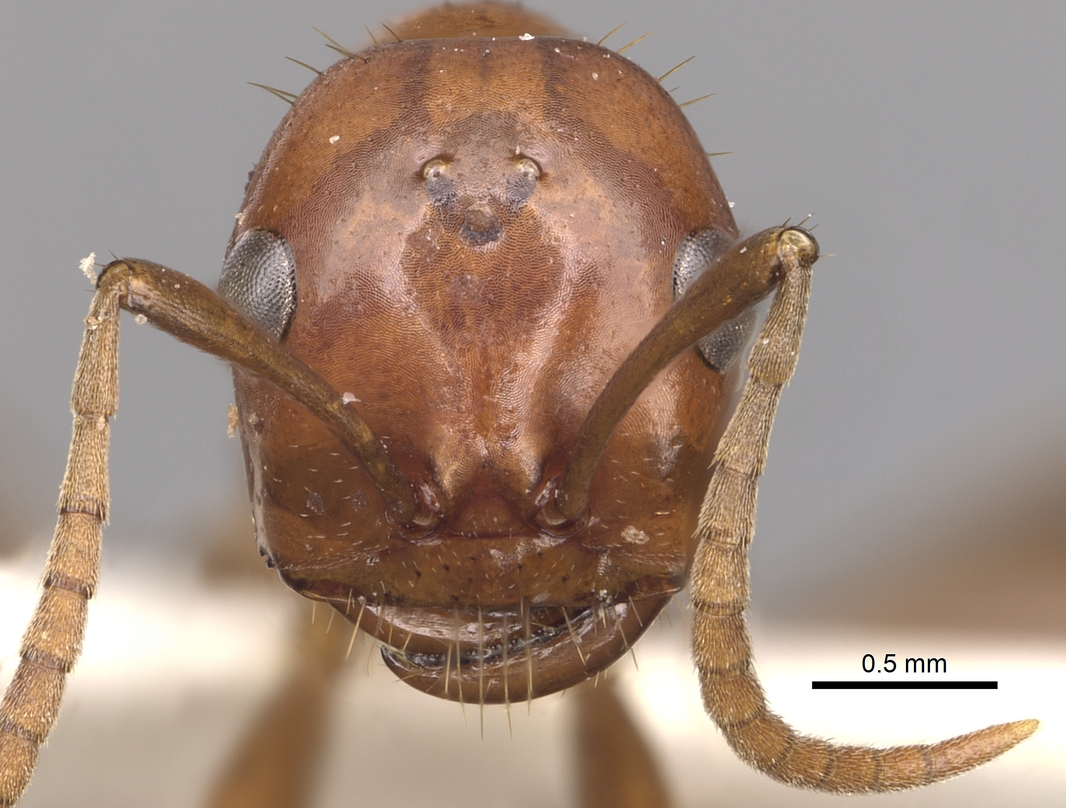Subfamily FORMICINAE by Joe A. MacGown, uploaded 21 July 2009, updated 25 July 2014 |
||
Polyergus lucidus, full face view of a worker (photo by Shannon Hartman, Antweb.org) |
Polyergus lucidus, profile view of a worker (photo by Shannon Hartman, Antweb.org) |
Polyergus lucidus, dorsal view of a worker (photo by Shannon Hartman, Antweb.org) |
Introduction Polyergus species are obligatory or true slave-making ants. In nest founding, the female enters a nest of the host species, eventually kills the rightful queen, and uses the host workers to tend her brood. Polyergus colonies conduct slave raids on nests of various species of Formica, and workers of the host are taken and used by the Polyergus colony to feed and rear the brood and excavate the nest. Polyergus workers are incapable of surviving without slaves. In laboratory colonies, a colony without slaves will starve to death even when plentiful food is available. (Hedlund, 2007; King and Trager, 2007). Polyergus lucidus is a shiny red colored species with a northern distribution that ranges as far south as Missouri and the Carolinas. The species name "lucidus" means shiny. Taxonomic History (from Trager 2013, Bolton 2014) Identification (from Smith 1947 and Trager 2013) This species can be separated from P. montivagus by its infuscation at the apex of gaster and erect hairs on the occipital lobes, both of which are lacking in P. montivagus. It can be distinguished from P. longicornis by its shorter antennal scapes, which are less than 1.2 times as long as the interocular distance in P. lucidus, but more than 1.4 times as long in P. longicornis; in P. lucidus, the head and alitrunk are shining, whereas, in P. longicornis, the body is opaque. Polyergus longicornis differs from P. breviceps by having much longer scapes, scapes in P. breviceps are not as long as interocular distance; by not having the antennal scapes terminating in a club (scapes in P. breviceps enlarged distally forming a club); and by having sparse pubescence on the gaster, whereas, pubescence on gaster of P. breviceps is dense). Biology and Economic Importance This species poses little in the way of economic importance, as is rarely encountered. However, if provoked or handled worker can inflict a somewhat painful bite. CANADA: Ontario. Literature Cited Creighton, W. S. 1950. The ants of North America. Bulletin of the Museum of Comparative Zoology 104:1-585. Dalla Torre, K. W. 1893. Catalogus Hymenopterorum hucusque descriptorum systematicus et synonymicus. Vol. 7. Formicidae (Heterogyna). Leipzig: W. Engelmann, 289 pp. Emery, C. 1893. Beiträge zur Kenntniss der nordamerikanischen Ameisenfauna. Zoologische Jahrbücher. Abteilung für Systematik, Geographie und Biologie der Tiere 7:633-682. Forel, A. 1886. Études myrmécologiques en 1886. Annales de la Société Entomologique de Belgique 30:131-215. Hedlund, K. S. 2007. The Ants: North America Catalog: Genus Polyergus. http://www.cs.unc.edu/~hedlund/playpen/dev/ants/catalog/ (accessed 6 June 2008). Ipser, R. M., M. A. Brinkman, W. A. Gardner, and H. B. Peeler. 2004. A survey of the ground-dwelling ants (Hymenoptera: Formicidae) in Georgia. Florida Entomologist 87 (3): 253-260. King, J. R. and J. C. Trager. 2007. Natural history of the slave making ant, Polyergus lucidus, sensu lato in northern Florida and its three Formica pallidefulva group hosts. 14 pp. Journal of Insect Science 7: 42, available online: insectscience.org/7.42 Mayr, G. 1870b. Neue Formiciden. Verhandlungen der Kaiserlich-Königlichen Zoologisch-Botanischen Gesellschaft in Wien 20:939-996 Smith, M. R. 1947. A Study of Polyergus in the United States, based on the workers (Hymenoptera: Formicidae). The American Midland Naturalist 38: 150-161. Trager, J. C. 2013. Global revision of the dulotic ant genus Polyergus (Hymenoptera: Formicidae, Formicinae). Zootaxa 3722 (4): 501–548. Wheeler, W. M. 1903. Some new gynandromorphous ants, with a review of the previously recorded cases. Bulletin of the American Museum of Natural History 19:653-683. Wheeler, W. M. 1917. A list of Indiana ants. Proceedings of the Indiana Academy of Science 26:460-466. Wheeler, G. C.; Wheeler, J. 1968. The ant larvae of the subfamily Formicinae (Hymenoptera: Formicidae): supplement. Annals of the Entomological Society of America 61:205-222. Links |
||





